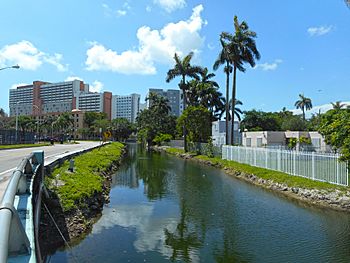Wagner Creek (Florida) facts for kids
Quick facts for kids Wagner Creek |
|
|---|---|

Wagner Creek near NW 16th Street Bridge and 14th Avenue (southeast view)
|
|
| Country | United States |
| Physical characteristics | |
| Main source | Biscayne Aquifer in old Allapatah Prairie 7 feet above sea level |
| River mouth | Miami River near NW 5th Street and 7th Avenue, Miami, Florida 25°46′44″N 80°12′26″W / 25.7788°N 80.2072°W |
| Length | 1.6 mi (2.6 km) |
Wagner Creek is a small river, called a tributary, that flows into the Miami River in Miami, Florida. It starts from underground water, called the Biscayne Aquifer, in an area that used to be a grassy plain. The creek flows through Miami neighborhoods like Allapatah, Spring Garden, and Overtown.
Contents
About Wagner Creek
This creek is about 1.6 miles (2.6 kilometers) long. It first appears above ground south of NW 20th Street, between 15th and 17th avenues. From there, it flows southeast in a straight line towards 15th Street.
The creek then turns east, passing through the Civic Center area. It makes a sharp turn south along 12th Avenue for one block, reaching 14th Street. From 14th Street, it flows southeast again, going under the SR836 highway towards 11th Street.
At 11th Street, Wagner Creek becomes a canal known as the Seybold Canal. It continues southeast, passing through the neighborhoods of Spring Garden to the west and Overtown to the east. The creek keeps flowing southeast until 8th Street, then goes straight south for three blocks. Finally, it joins the Miami River west of NW 5th Street and 7th Avenue.
History of the Creek
Early Settlers and Mills
People first settled near the lower part of the creek, now called the Seybold Canal, in the early 1840s. A man named William English built a mill there. This mill made starch from a plant called coontie.
In the 1850s, William Wagner and a business partner started another coontie mill nearby. The creek was later named "Wagner Creek" after William Wagner. A natural spring (a place where water flows out of the ground) was found on the creek. Because of this fresh water, Henry Flagler built the private Miami Water Company there in 1899. Today, a Miami-Dade Water and Sewer Treatment plant is located in the same area.
The Seybold Canal Name
By 1919, a businessman from Miami named John Seybold made the creek deeper and wider. He also built a turning basin, which is a wider area where boats can turn around. Because of his work, officials decided to rename the creek "Seybold Canal" in his honor.
John Seybold also bought land next to the canal and the Miami River. He divided this land into plots for homes. He advertised it as a great place to live during the Florida land boom of the 1920s.
Pollution and Cleanup Efforts
For many years, Wagner Creek and Seybold Canal were neglected and became very polluted. It was even known as Florida's most polluted waterway. Instead of being a clean freshwater creek, people used it to dump chemicals, garbage, and dirty water from the streets.
In 2003, the City of Miami asked to clean out the creek. During the approval process, tests were done on the water and mud from the creek. The results showed high levels of harmful chemicals like dioxins and heavy metals. However, no immediate action was taken because the Army Corps of Engineers was busy cleaning the Miami River, which took about five years.
Between 2007 and 2009, a company called CH2M HILL did more tests. They found that about 61 tons of polluted mud needed to be removed. Finally, in February 2015, the city announced that $20 million had been approved for the cleanup.
On July 31, 2017, city officials and members of the Miami River Commission held a ceremony to announce the start of the creek's restoration. The cleanup involved removing mud and garbage and fixing up the creek. This work took about a year and finished in May 2018.
See also
 In Spanish: Arroyo Wagner para niños
In Spanish: Arroyo Wagner para niños









